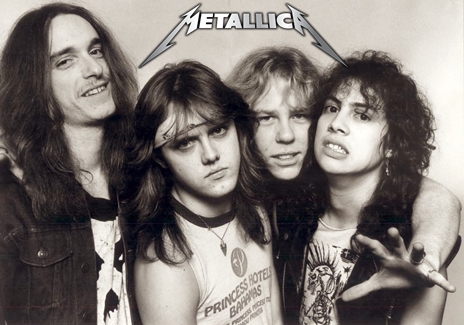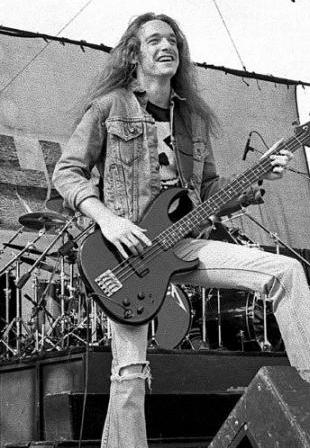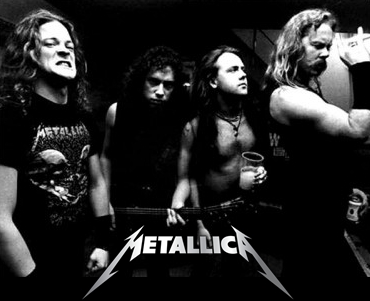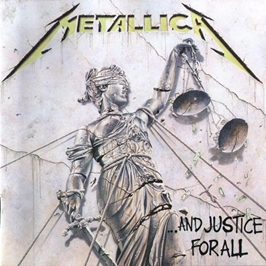With the lineup complete, Metallica recorded their first song, "Hit the Lights," in late 1981. The song was included on Metal Massacre I, and helped generate significant buzz about the band before they had even performed live. The band was upset that early copies of the compilation listed their name as Mettallica, but the benefit of the exposure heavily outweighed the perceived slight. The first Metallica gig took place on March 14, 1982 at Radio City in Anaheim, California. Several other gigs followed in the L.A. area, including an opening slot for British heavy metal heavyweights Saxon, increasing the demand for more recordings from the band. The band recorded a demo entitled Power Metal, a name also used by Hetfield to describe the band's sound. The term "thrash music" wouldn't be coined for another two years, when Kerrang! Magazine journalist Malcolm Dome used it to describe the Anthrax song "Metal Thrashing Mad."
The Power Metal demo, along with successor the No Life 'til Leather demo, only increased the hunger of the band's growing fan-base for new material. The demos were especially getting popular in New York City and San Francisco, where a larger contingency of bands were adopting the extreme metal sound that would become the various forms of thrash. The band landed a few gigs in the Bay Area, including a show with opening act Trauma. Hetfield, Ulrich and Mustaine were blown away by Trauma's bass player Cliff Burton, and dismissed McGovney and invited Burton to join. The move wasn't a tough sell, as the band found Bay Area crowds much more into its music than the "there to be seen" crowds in L.A. The terms were agreed to and Metallica relocated to El Cerrito, a San Francisco suburb, in early 1983. Another demo entitled Megaforce was recorded to introduce Burton, before the band set its sights on recording its debut full length.
 Classic Metallica lineup
Classic Metallica lineup
|
|
|
|
|
With songs written, Metallica was ready to hit the studio to lay down its first record. Metal Blade was strapped for cash at the time, however, and unable to cover the recording costs, so the band began looking into alternative options. New York concert promoter and record store owner Johnny Zazula, known more commonly as Johnny Z, had heard the band's demos and agreed to broker a deal with a New York label for Metallica. Labels weren't receptive, however, and Johnny Z raised the money to record the album and formed his own label, Megaforce Records, to release it. The band flew out to New York to begin recording, but turmoil struck before the sessions began. As young men in their early-to-mid 20s, the Metallica boys were known to engage in the occasional celebration, living the Rock 'n Roll life complete with drinking and drugs. Mustaine took it to the extreme, however, and would often show up late for gigs or too drunk to perform. The guitarist's outbursts occasionally sparked confrontations with other band members, and his lack of professionalism was wearing thin. Mustaine showed up drunk to a New York gig just before recording was to begin, marking the proverbial last straw. Mustaine was fired and sent home on a bus, and Exodus guitarist Kirk Hammett was hired and flown in to record the album.
With Hammett on board, the Metallica lineup that recorded their first three records was in place. This lineup is considered the classic lineup of the band, even though Mustaine still had a significant impact on their debut. With Hammett brought in at the last minute, most of the guitar solos on the album were written by Mustaine, who also received writing credit for four of the album's tracks. Mustaine would go on to form Megadeth, including the song "Mechanix" on the band's 1985 debut Killing Is My Business...And Business Is Good! The song was originally written as a song for Metallica's debut, but was reworked and retitled "The Four Horseman" after Mustaine was dismissed.
Metallica's debut record was initially titled Metal Up Your Ass, and cover art created depicting a toilet and a hand holding a dagger emerging from it. Johnny Z felt the title and artwork were too extreme, and convinced the band to change the name to Kill 'Em All. The album hit stores July 25th, 1983, becoming an instant success with the small but growing throngs of fans of extreme metal. Megaforce had a limited promotional budget, however, and the album was not a commercial success until three years later, when the success of Master of Puppets drove sales of earlier Metallica releases. The renewed interest in their back catalog allowed Kill 'em All to peak at No. 120 on the Billboard 200 chart, and the album would eventually eclipse 3 million copies sold in the US. Critical reception of the record was solid, on the other hand, at least among those music publications who were even acknowledging extreme metal acts at the time. The band embarked on a pair of tours with UK rockers Raven and black metal pioneers Venom, further increasing their exposure with shows in Europe. During this tour, the band began debuting tracks written for a second record, creating a huge demand in the underground metal scene for more from the quartet.
|
In February, 1984, Metallica began recording its sophomore album at Sweet Silence Studios in Copenhagen, Denmark, with studio owner Flemming Rasmussen producing. Recording was finished in about three weeks, and Ride the Lighning hit stores on July 27th, 1984. The record was the last to give any writing credits to Dave Mustaine, and the first to give credits to Hammett, finalizing the transition that began with Mustaine's ouster. Sales of the album were much better than those of its predecessor, thanks to a growing international audience, and the effort would eventually sell 6 million copies in the US. The album reached the A&R director at Elektra Records, who liked what he heard and signed the band. A limited edition single for "Creeping Death" was released by the band's European distributor, Music for Nations, selling out 40,000 copies as a UK import release sold in the US. The single also featured Metallica covers of Diamond Head's "Am I Evil?" and "Blitzkrieg" from the band Blitzkrieg, both included on a later Elektra reissue of Kill 'em All.
|
|
|
With a pair of albums under its belt, and its popularity surging, Metallica embarked on its first major tour as a headliner in 1985, splitting the bill with W.A.S.P. And following supporting act Armored Saint. August 1985 saw the band perform in front of its biggest audience yet when they performed at the Monsters of Rock festival at Castle Donington in the UK. Just a few weeks later, on September 1st, 1985, Metallica returned to Sweet Silence Studios and began working with Rasmussen on their third record. Recording was wrapped up on December 27th, though neither Rasmussen nor the band was happy with the finished product. The masters were sent to L.A., relinquishing the final mixing duties to Michael Wagener, an engineer revered for his work with Motley Crue, Accept, Dokken and Alice Cooper, among others. Wagener finished mixing, and the album was released on February 24th, 1986.
Master of Puppets quickly became Metallica's biggest-selling album yet, peaking at position 29 on the Billboard 200 and quickly becoming the first thrash metal album to be certified platinum for selling over one million copies in the US. Critical reception for the effort couldn't have been better, as a number of critics that had previously ignored thrash took notice, and thrash-friendly media outlets immediately hailed the album as one of the greatest metal albums of all time. While subsequent Metallica releases reached a wider audience, Master is widely considered the masterpiece from the band by those who were fans during their formative years. The album is still considered by many to be the best thrash album of all time, and is often counted among the top five or ten rock albums ever. Each of the album's eight tracks has been covered multiple times over the years, by artists of nearly every extreme metal sub-genre, and several tracks from the album have become staples at American sporting events.
|
With their popularity exploding, Metallica agreed to embark on a world tour opening for former Black Sabbath frontman Ozzy Osbourne, whose popularity had never been bigger. The tour introduced Metallica to a much wider audience, as Ozzy fans were forced to reconsider their reluctance towards thrash and left those shows with a more open mind and as fans of Metallica. The tour rolled on, until, on September 27th, 1996, when tragedy struck just outside of Stockholm, Sweden. The band had performed earlier that night in Stockholm, and were on their way to the next gig, when a tragic accident claimed the life of bassist Cliff Burton. According to reports, the bassist had been sleeping when the bus began swerving, threw him out a broken window and rolled over on top of him. A group of Metallica members and road crew tried to save him, and even managed to lift the bus slightly, but were unable to get him out from under the bus.
With Burton's death, a number of tour dates were canceled and the band headed back home to San Francisco to figure out their next move. Auditions were held to find Burton's replacement, including tryouts by Les Claypool of Primus and Blind Illusion and Tony Gregory, who later joined Prong. The three remaining members of the band finally settled on Flotsam and Jetsam's Jason Newsted, who immediately set to work on learning the band's songs. Flotsam and Jetsam, for whom Newsted was not only the bassist but also their primary lyricist, hired Sacred Reich's Phil Rind and another bassist to fill in while the band sought a permanent replacement. Eventually, the band found Newsted's replacement in Troy Gregory, who was turned down for the job Newsted left to fill. Shortly after Newsted joined, the band moved from its rehearsal house fondly dubbed the "Metalli-mansion" to new digs in Marin County. In July 1987, the band recorded EP consisting of covers of songs originally released by punk and New Wave of British Heavy Metal bands in the late-70s and early 80s. The result was entitled The $5.98 E.P.: Garage Days Re-Revisited, and further cemented the band's place in extreme metal history. A video was also released around this time as a tribute to Cliff Burton. Entitled Cliff 'em All, the release featured home video, pictures and live footage from Burton's three years with Metallica and before.
|

Cliff Burton (1962-1986)
|
|
In January, 1988, Metallica entered the studio to begin working on its fourth album, taking just over three months to lay it down at One on One Studios in L.A. ...And Justice for All hit stores in August, quickly becoming the band's biggest success to date. Metallica's first Top 10 album on the Billboard 200, the record was certified platinum just nine weeks after its release, and peaked at No. 6 on the chart. Critical success was superb as well, although there was some criticism of the sound of Ulrich's drums and the overall guitar sound, though those criticisms were largely ignored as the band's popularity continued to rise. ...And Justice for All was nominated for a Grammy, in the newly-created category of Best Hard Rock/Metal Performance Vocal or Instrument category, and expected to win by most observers at the time. The award went to Jethro Tull, however, surprising nearly everybody, including Jethro Tull, who did not attend the ceremony because they were convinced Metallica was going to win.
Shortly after the release of the fourth album, Metallica released their first-ever music video, written for the ...And Justice for All track "One." The video was a huge hit on MTV, and helped the band expand their audience even further. The album would remain on the Billboard chart for 83 weeks, and would eventually earn platinum, certification in Finland, Canada, Germany and the US, selling 8 million copies in the US alone. Despite the commercial success, however, some die-hard fans consider the album as the beginning of the end. Most early fans of the band considered ...And Justice the last great Metallica record, while others think it was too commercial. This impression was only solidified by the "One" video, as it brought an end to Metallica's boycott of MTV and was seen by some as evidence the band was giving up on their anti-establishment way of doing things in the early days.
|
 Metallica w/ new bassist Jason Newsted, 1987
Metallica w/ new bassist Jason Newsted, 1987
|
|
 ...And Justice for All
...And Justice for All
|
|
|
Metallica hit the studio to begin work on their fifth album in October 1990, recruiting Bob Rock to helm the effort and ending their relationship with Flemming Rasmussen, who had produced albums number 2, 3, 4. Rock was in demand at the time after producing Kingdom Come's 1988 self-titled record followed by The Cult's Sonic Temple, Blue Murder's eponymous debut and Motley Crue's Dr. Feelgood, all in '89. Former Van Halen frontman David Lee Roth had also just hired Rock to helm his third solo effort. Rock would go on to produce three more studio albums plus the new material on the 1998 covers album Garage Inc., essentially a reissue of The $5.98 E.P.: Garage Days Re-Revisited with bonus cover songs. Rock even spent four years as Metallica's bassist when Jason Newsted left in 2001. Rock recorded all the bass lines on St. Anger between May 2002 and April 2003, but was the live bass player a number of times before Robert Trujillo (Suicidal Tendencies, Ozzy Osbourne, Black Label Society) was hired in February 2003. At one point some 1,500 fans signed a petition in an attempt to convince Metallica to sever ties with Rock, whom they believed had excessive creative control over the band's sound and musical style. For longtime Metallica fans who had followed the band from the beginning, The Black Album represented the end of the band's thrash career. Metallica was now nothing more than a pop-influenced, alternative heavy metal band. In fairness, the move was necessary, as the growing popularity of grunge was not only obliterating the glam metal scene, but also impacted thrash and other forms of extreme metal.
|
|

